Dental office protocols to combat the SARS-CoV-2 (COVID-19) pandemic include mouth washing for an extended 60 s, thereby reducing detectable oral virus. However, it is unclear whether this protocol has any effects on the newly identified periodontal pathogen and obesity-related bacterium often found
[...] Read more.
Dental office protocols to combat the SARS-CoV-2 (COVID-19) pandemic include mouth washing for an extended 60 s, thereby reducing detectable oral virus. However, it is unclear whether this protocol has any effects on the newly identified periodontal pathogen and obesity-related bacterium often found among pediatric patients,
Selenomonas noxia. To determine if the mouthwash protocol has any measurable effect on
S. noxia amongst pediatric patients, clinical pediatric saliva samples were obtained from pediatric patients during routine visits for clinical care and treatment. Using an approved protocol, two saliva samples were collected on the same visit before and after chlorhexidine mouthwash (Sample A, Sample B). The third sample (Sample C) was taken at the recall appointment—usually between two and eight weeks later. A total of n = 97 pre-mouthwash samples, and an equal number of matching post-mouthwash samples (n = 97) were collected, with a small number of matching recall samples (n = 36) that were subsequently collected and identified. The demographic composition of the study sample was analyzed using Chi square statistics. Sample DNA from the matching pre-, post-, and recall collections (Sample A, Sample B, and Sample C) was isolated and screened using qPCR and validated primers, which revealed that 11.1% (n = 4/36) from Sample A tested positive for
S. noxia with 0% (n = 0/36) of Sample B testing positive and 13.9% (n = 5/36) of the recall (Sample C) testing positive. In addition, comparative analysis of the qPCR cycle threshold data revealed relatively lower expression (quantity) of
S. noxia DNA among the recall samples, as determined by two-tailed
t-tests (
p=0.004). These data and results provide new evidence for the oral prevalence of
S. noxia among pediatric patients, while also demonstrating that the COVID-19 protocol of mouth washing prior to clinical treatment for periods extending up to 60 s may be sufficient to reduce the levels of detectable
S. noxia—at least temporarily. More research will be needed to determine whether these effects may be limited to the short- or may exhibit more lasting effects in the long-term.
Full article






